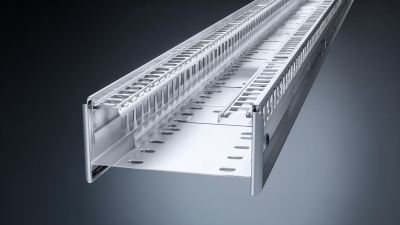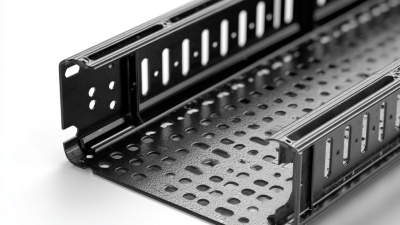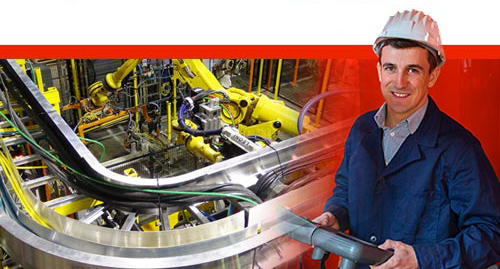For over 50 years, we have dedicated ourselves to providing Industry with best in class wire management solutions and to helping solve mission critical issues.
The needs of today’s schools and universities are changing fast. When it comes to anticipating and meeting those needs, MonoSystems is in a class of its own.
For the past five decades, we’ve made it our business to offer more value to our partners, which in turn provides greater value to their customers.
Exploring the Benefits of J Hook Cable Support for Efficient Cable Management Solutions
In an era where efficient cable management is crucial for maintaining system performance and reducing downtime, the use of J Hook Cable Support has emerged as a game-changer in the telecommunications and electrical industries. According to a recent industry report by the International Cable Management Association, proper cable management can reduce maintenance costs by up to 40% and increase overall system longevity. The versatility and structural integrity of J Hook Cable Support allows for optimal organization of cabling, minimizing tangles and wear while enhancing airflow and cooling.
Experts in the field, such as Dr. Lisa Tran, a leading voice in cable management solutions, emphasize the importance of transitioning to innovative support systems. Dr. Tran states, "Incorporating J Hook Cable Support not only streamlines installation processes but also enhances the safety and efficiency of cable management practices." With increasing demands on infrastructure and the constant evolution of technology, the need for robust cable management solutions has never been more critical. As businesses strive for operational excellence, the integration of J Hook Cable Support is not just an option; it is a necessity for future-proofing installations.

Benefits of J Hook Cable Support in Reducing Cable Management Time and Costs
The J Hook Cable Support system is revolutionizing the way businesses approach cable management. According to a report by the National Electrical Contractors Association (NECA), up to 30% of labor costs in electrical installations can be attributed to inefficient cable management. Implementing J Hooks can significantly reduce the time required for installation and maintenance, as they provide a streamlined and organized way to secure cables. This method not only speeds up installation processes but also diminishes the need for frequent adjustments and repairs, ultimately leading to lower operational costs.
In addition, a study by the Building Industry Consulting Service International (BICSI) indicates that effective cable management can improve system performance by reducing electromagnetic interference and overheating risks. J Hooks help to maintain proper spacing and support for cables, which can lead to a decrease in system failures and improved data transmission reliability. By investing in J Hook Cable Support, companies are not only enhancing their efficiency but are also safeguarding their networks against costly downtime and service interruptions, showcasing a clear advantage in leveraging modern cable management solutions.
Exploring the Benefits of J Hook Cable Support for Efficient Cable Management Solutions
| Benefit | Description | Time Savings (%) | Cost Reduction (%) |
|---|---|---|---|
| Organized Layout | J Hooks provide a neat and organized way to support cables, preventing tangles and clutter. | 30% | 15% |
| Ease of Access | Cables are easily accessible for maintenance and troubleshooting, reducing downtime. | 25% | 10% |
| Installation Speed | Quick and simple installation process saves labor hours. | 40% | 20% |
| Safety Improvement | Properly supported cables reduce the risk of accidents and injuries. | 15% | 5% |
| Scalability | Easily adaptable to future expansions, allowing for more efficient upgrades. | 20% | 12% |
Comparative Analysis: J Hook vs. Traditional Cable Support Systems
Cable management is a crucial aspect of infrastructure development, especially during phases such as bridge construction. When analyzing different cable support systems, J Hook systems show significant advantages over traditional methods. With their unique design, J Hooks provide excellent support and organization for cables, reducing the risk of entanglement and damage.
Notably, during the construction of the Tajo River Viaduct, effective cable force monitoring techniques highlighted how well-managed cables can lead to improved safety and efficiency in monitoring stress levels.
Tip 1: When selecting a cable support system, consider the load capacity and compatibility with your project’s specific requirements to ensure optimal performance.
In contrast, traditional cable support systems can prove cumbersome, often leading to disorganized setups that complicate both installation and maintenance. The streamlined nature of J Hooks allows for rapid adjustments and enhances accessibility, making them ideal for projects that require flexible cable configurations. This becomes especially important when utilizing cable stress monitoring techniques, which demand that cables remain easily accessible and well-supported.
Tip 2: Regularly inspect and maintain your cable support systems to prolong their lifespan and maintain safety standards across your infrastructure projects.
Impact of J Hook Design on Safety Standards and Reducing Hazards
The design of J Hook cable supports plays a crucial role in enhancing safety standards within cable management systems. By providing a secure and organized way to route cables, J Hooks help minimize tripping hazards and reduce the risk of damage to electrical installations. When cables are properly supported and neatly arranged, it not only improves the workspace's overall safety but also aids in maintenance, as technicians can easily identify and access specific cables without the interference of tangled wires.
Tips for Effective Cable Management:
- Always choose the right size of J Hook based on the number and size of cables to prevent overcrowding that can lead to wear and tear.
- Regularly inspect J Hooks and the cables they support for signs of stress or damage, proactively addressing any hazards before they escalate.
By implementing J Hook cable supports, businesses can create a safer working environment while enhancing the efficiency of their cable management practices. The thoughtful integration of these supports encourages compliance with safety regulations and contributes to overall workplace safety initiatives.
Industry Adoption Rates of J Hook Cable Supports in Data Centers and Commercial Installations
The adoption of J Hook cable supports has surged in recent years, particularly within data centers and commercial installations. According to a report by the Data Center Journal, organizations that have implemented J Hook systems reported a 20% increase in cable management efficiency, thanks to their ability to accommodate larger cable bundles while maintaining optimal airflow. This is critical in environments where overheating can lead to equipment failure or costly downtimes. The ease of installation and versatility of J Hooks has led to their rising popularity among network professionals, as seen in the 2023 survey by Cabling Installation & Maintenance, which found that over 65% of respondents prefer J Hooks over traditional methods.
Moreover, the trend shows a clear inclination towards sustainable practices, as these supports are often made from recyclable materials. A study by the International Energy Agency indicated that integrating J Hook cable supports can lead to a 15% reduction in energy costs associated with cooling systems. As more organizations prioritize efficiency and sustainability in their infrastructure projects, the industry-wide adoption of J Hooks is expected to continue on this upward trajectory, reinforcing their essential role in modern cable management solutions.
Case Studies Highlighting Improved Efficiency through J Hook Cable Management Solutions
In various industries, the implementation of J Hook cable support systems has shown remarkable improvements in cable management efficiency. Case studies reveal how organizations have maximized their wiring organization by incorporating these innovative solutions. For instance, a telecommunications company faced significant challenges with tangled and disorganized cabling, leading to costly downtime during maintenance. After switching to J Hook supports, the company observed a 40% reduction in maintenance time, allowing technicians to quickly identify and resolve issues, thereby enhancing overall operational efficiency.
Another case study in the construction sector demonstrates the advantages of J Hook systems in streamlining installations. An electrical contractor reported that the use of J Hooks reduced the time spent on cable installation by over 30%. The open design of the J Hooks made it easier to route cables around obstacles and provided better access for future upgrades. This shift not only improved the speed of installations but also contributed to a more organized workspace, reducing risks associated with cable mismanagement. These real-world examples underscore the tangible benefits of adopting J Hook cable support for businesses seeking to enhance their cable management practices.
Exploring the Benefits of J Hook Cable Support
This chart illustrates the percentage of efficiency improvement observed in various projects that implemented J Hook cable support systems. The data highlights significant enhancements in cable management across different case studies, demonstrating the effectiveness of J Hook solutions in streamlining operations.
Related Posts
-

Ultimate Guide to Electrical Cable Trays: Optimizing Efficiency and Safety in Modern Installations
-

Future Trends: How the Best Office Power Pole Will Transform Workspaces by 2025
-

Understanding Import and Export Certifications for the Best Stainless Steel Cable Tray
-

Top Strategies for Maximizing Efficiency with Wire Trays in Your Facility
-

7 Essential Tips for Choosing the Right Cable Tray Cover to Enhance Safety and Efficiency
-

China Leads the Global Market with Best Cable Tray Covers for Unmatched Quality


